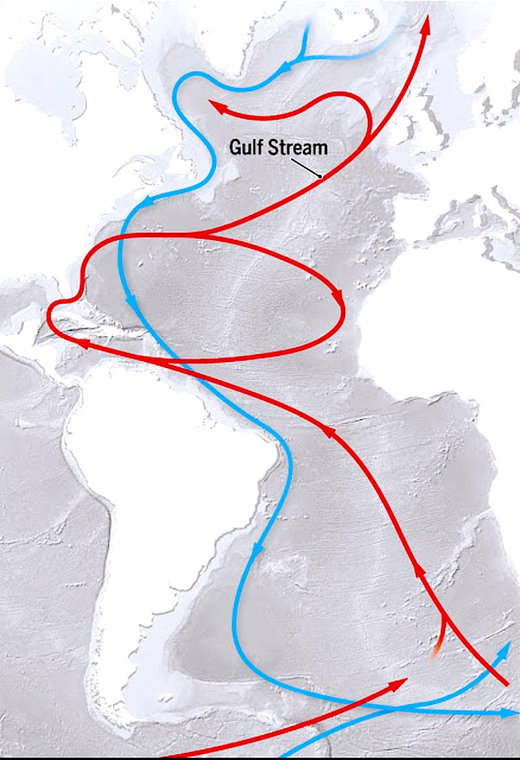
© inhabitat.com
Mysteriously, ice cores from Greenland and Antarctica show that these sudden shifts—which occurred
every 1500 years or so—were out of sync in the two hemispheres: When it got cold in the north, it grew warm in the south, and vice versa. Now, scientists have implicated
the culprit behind those seesaws—changes to a conveyor belt of ocean currents known as the Atlantic Meridional Overturning Circulation (AMOC).These currents, which today
drive the Gulf Stream, bring warm surface waters north and send cold, deeper waters south. But
they weakened suddenly and drastically, nearly to the point of stopping, just before several periods of abrupt climate change, researchers report today in
Science. In a matter of decades, temperatures plummeted in the north, as the currents brought less warmth in that direction. Meanwhile, the backlog of warm, southern waters allowed the Southern Hemisphere to heat up.
AMOC slowdowns have long been suspected as the cause of the
climate swings during the last ice age, which lasted from 110,000 to 15,000 years ago, but never definitively shown.
The new study "is the best demonstration that this indeed happened," says Jerry McManus, a paleo-oceanographer at Columbia University's Lamont-Doherty Earth Observatory, and a study author. "It is very convincing evidence," adds Andreas Schmittner, a climate scientist at Oregon State University, Corvallis.
"We did not know that the circulation changed during these shorter intervals."
To assess the strength of ancient ocean currents over the course of 35,000 years in the middle of the ice age, McManus and his colleagues examined a 10-meter section of a 38-meter sediment core drilled from the bottom of the Atlantic Ocean.
The core came from an elevated patch of sea floor known as the Bermuda Rise, where sediments accumulate abnormally fast. The thick layer allows for a more detailed reading of chemical changes within the sediments when they were buried.
Circulation slowdown
© whatsorb.blogspot.comAtlantic currents rapidly changing.
The researchers measured the ratio of two products of radioactive decay:
protactinium-231 and thorium-230. These daughter isotopes come from trace amounts of uranium that are dissolved everywhere in seawater. If the ocean were as still as a bathtub, the two daughter isotopes would bind to sediment particles, settle downward, and become buried at a constant ratio. But thorium gloms on to particles more readily than protactinium. It is therefore buried more readily, whereas protactinium tends to be carried away by ocean currents for burial elsewhere.
At places like the Bermuda Rise, where the Atlantic conveyor belt is typically strong, little protactinium ends up in the sediments—except for four instances when the ratio to thorium rose sharply in a matter of decades to centuries, indicating the AMOC's sudden weakening.A 2014 study of the AMOC, based on a core from a nearby spot on the Bermuda Rise, found that the currents maintained much of their strength throughout the last glacial period. But because that team took fewer samples from the core and missed the sharp swings in strength. "Now these [new] guys have increased incredibly the data resolution," says Jörg Lippold, a paleo-oceanographer at the University of Heidelberg in Germany and the leader of the 2014 study. "They found the peaks we missed."
Still unclear is what triggered the AMOC's sudden slowdowns. Many of the drops correspond to so-called
Heinrich events: rapid releases of icebergs from Canada's ice sheet. These iceberg armadas often chugged through the Hudson Strait of Canada and may have
discharged more ice into the Atlantic Ocean than contained in the entire ice cap of Greenland, raising ancient sea levels by 10 meters. The meltwater brought incredible amounts of freshwater to the North Atlantic, precisely where ocean currents cool off and sink.
Because freshwater is less dense than saltwater, it can plug up the AMOC, preventing the overturning and deep water formation that fuels the circulation's engine. The slowdowns persisted for 1500 years or so, then the AMOC would suddenly regain strength as freshwater melt dissipated and the currents reached a certain threshold, McManus says.
But weak AMOCs are not always accompanied by a Heinrich event, and the timing is fuzzy—some Heinrich events seem to occur after the AMOC already began to weaken.
"The Heinrich events may be a response to the change in the overturning circulation rather than a cause," Schmittner says.
Another question is whether the AMOC—currently known to be in decline—could drop off suddenly today, as depicted in the 2004 movie The Day After Tomorrow, causing temperatures to plummet across northwestern Europe. Schmittner says the past provides an eye-opener.
"It's evidence that this really did happen in the past, on short time scales." But McManus says that studies looking deeper into the ice ages have found that the 1500-year climate oscillations tend not to be nearly as strong during interglacial periods. "It would suggest that this kind of thing isn't so likely to happen today," he says. On the other hand, he adds,
"In most interglacials, Greenland didn't melt ... and Greenland is currently melting."
Comment: Natural variability? Climate trends? Or precursor to an ice age? The ocean circulation slowdown, coupled with longer winters than usual, may be contributors to drastic changes that could occur quickly before evidence becomes available, before interpretation becomes proven fact.